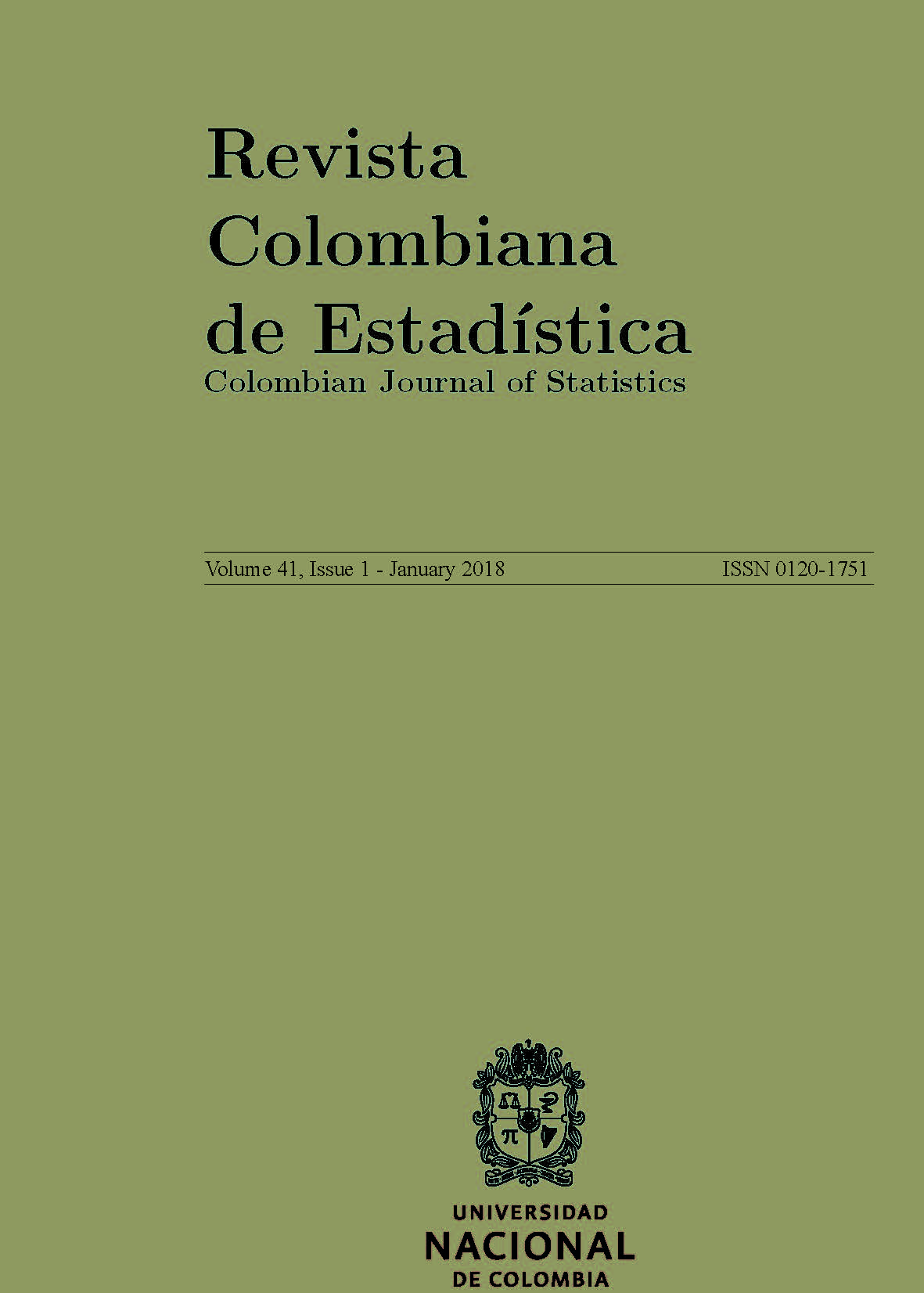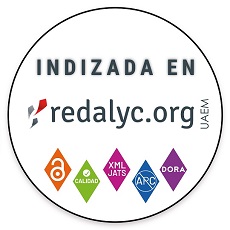The Odd Log-Logistic Dagum Distribution: Properties and Applications
La distribución Odd Log-Logistica de Dagum: propiedades y aplicaciones
DOI:
https://doi.org/10.15446/rce.v41n1.66542Palabras clave:
Dagum Distribution, Maximum Likelihood, Odd Log-Logistic Family, Order Statistics (en)distribución Dagum, familia Odd-Log-Logística, máxima verosimilitud, estadísticas de orden (es)
Descargas
This paper introduces a new four-parameter lifetime model called the odd log-logistic Dagum distribution. The new model has the advantage of being capable of modeling various shapes of aging and failure criteria. We derive some structural properties of the model odd log-logistic Dagum such as order statistics and incomplete moments. The maximum likelihood method is used to estimate the model parameters. Simulation results to assess the performance of the maximum likelihood estimation are discussed. We prove empirically the importance and flexibility of the new model in modeling real data.
Referencias
Andrews, D. F. & Herzberg, A. M. (2012), Data: a collection of problems from many fields for the student and research worker, Springer Science & Business Media.
Armitage, P. & Berry, G. (1987), Distribution-free methods, in 'Statistical methods in medical research', Blackwell Scienti_c Oxford, London, Edinburgh, Boston, Melbourne, pp. 408-420.
Barlow, R., Toland, R. & Freeman, T. (1984), A bayesian analysis of stress-rupture life of kevlar 49/epoxy spherical pressure vessels, in 'Proc. Conference on Applications of Statistics, Marcel Dekker, New York'.
Cooray, K. & Ananda, M. M. (2008), 'A generalization of the half-normal distribution with applications to lifetime data', Communications in Statistics-Theory and Methods 37(9), 1323-1337.
Da Cruz, J., Cordeiro, G., Ortega, E. & Alizadeh, M. (2014), 'A new family ofdistributions: Theory and applications in survival analysis', Statistics .
Dagum, C. (1977), 'New model of personal income-distribution-speci_cation and estimation', Economie appliquée 30(3), 413-437.
Domma, F. (2002), 'Landamento della hazard function nel modello di dagum a tre parametri', Quaderni di Statistica 4, 1-12.
Domma, F. (2007), 'Asymptotic distribution of the maximum likelihood estimators of the parameters of the right-truncated dagum distribution', Communications in Statistics-Simulation and Computation 36(6), 1187-1199.
Domma, F. & Condino, F. (2013), 'The beta-dagum distribution: deffinition and properties', Communications in Statistics-Theory and Methods 42(22), 4070-4090.
Domma, F. & Condino, F. (2016), 'Use of the beta-dagum and beta-singh-maddala distributions for modeling hydrologic data', Stochastic Environmental Research and Risk Assessment pp. 1-15.
Domma, F., Giordano, S. & Zenga, M. (2011), 'Maximum likelihood estimation in dagum distribution with censored samples', Journal of Applied Statistics 38(12), 2971-2985.
Domma, F., Latorre, G. & Zenga, M. (2012), 'The dagum distribution in reliability analisys.', Statistica & Applicazioni 10(2).
Elbatal, I. & Aryal, G. (2015), 'Transmuted dagum distribution with applications', Chilean Journal of Statistics (ChJS) 6(2).
Evans, D. L., Drew, J. H. & Leemis, L. M. (2008), 'The distribution of the kolmogorov-smirnov, cramer-von mises, and anderson-darling test statistics for exponential populations with estimated parameters', Communications in Statistics-Simulation and Computation 37(7), 1396-1421.
Gleaton, J. & Lynch, J. (2006), 'Properties of generalized log-logistic families of lifetime distributions', Journal of Probability and Statistical Science 4(1), 51-64.
Gradshteyn, I. & Ryzhik, I. (2007), Table of Integrals, Series, and Products, Elsevier/Academic Press.
Huang, S. & Oluyede, B. O. (2014), 'Exponentiated kumaraswamy-dagum distribution with applications to income and lifetime data', Journal of Statistical Distributions and Applications 1(1), 1-20.
Kenney, J. & Keeping, E. (1962), Mathematics of Statistics, Vol. 1, Princeton, NJ: Van Nostrand.
Kleiber, C. (1996), 'Dagum vs. singh-maddala income distributions', Economics Letters 53(3), 265-268.
Kleiber, C. (1999), 'On the lorenz order within parametric families of income distributions', Sankhy a: The Indian Journal of Statistics, Series B pp. 514-517.
Kleiber, C. (2008), A guide to the dagum distributions, in 'Modeling Income Distributions and Lorenz Curves', Springer, pp. 97-117.
Kleiber, C. & Kotz, S. (2003), Statistical size distributions in economics and actuarial sciences, Vol. 470, John Wiley & Sons.
Moors, J. (1988), 'A quantile alternative for kurtosis', The Statistician pp. 25-32.
Navarro, J., Franco, M. & Ruiz, J. (1998), 'Characterization through moments of the residual life and conditional spacings', Sankhy a: The Indian Journal of Statistics, Series A pp. 36-48.
Oluyede, B. O., Motsewabagale, G., Huang, S., Warahena-Liyanage, G. & Pararai, M. (2016), 'The dagum-poisson distribution: model, properties and application', Electronic Journal of Applied Statistical Analysis 9(1), 169-197.
Oluyede, B. O. & Rajasooriya, S. (2013), 'The mc-dagum distribution and its statistical properties with applications', Asian Journal of Mathematics and Applications 2013.
Oluyede, B. O. & Ye, Y. (2014), 'Weighted dagum and related distributions', Afrika Matematika 25(4), 1125-1141.
Paranaíba, P. F., Ortega, E. M., Cordeiro, G. M. & Pescim, R. R. (2011), 'The beta burr xii distribution with application to lifetime data', Computational Statistics & Data Analysis 55(2), 1118-1136.
Pérez, C. G. & Alaiz, M. P. (2011), 'Using the dagum model to explain changes in personal income distribution', Applied Economics 43(28), 4377-4386.
Quintano, C. & D'Agostino, A. (2006), 'Studying inequality in income distribution of single-person households in four developed countries', Review of Income and Wealth 52(4), 525-546.
Silverman, B. W. (1986), Density estimation for statistics and data analysis, Vol. 26, CRC press.
Tahir, M., Cordeiro, G. M., Mansoor, M., Zubair, M. & Alizadeh, M. (2016), 'The weibull-dagum distribution: properties and applications', Communications in Statistics-Theory and Methods (just-accepted).
Thode, H. C. (2002), Testing for normality, Vol. 164, CRC press.
Torabi, H., Montazeri, N. H. & Grané, A. (2016), 'A test for normality based on the empirical distribution function', SORT 40(1), 3-36.
Cómo citar
APA
ACM
ACS
ABNT
Chicago
Harvard
IEEE
MLA
Turabian
Vancouver
Descargar cita
CrossRef Cited-by
1. Ahmed Z. Afify, Mazen Nassar, Gauss M. Cordeiro, Devendra Kumar. (2020). The Weibull Marshall–Olkin Lindley distribution: properties and estimation. Journal of Taibah University for Science, 14(1), p.192. https://doi.org/10.1080/16583655.2020.1715017.
2. Yongjing Wang, Zubair Ahmad, Faridoon Khan, Dalia Kamal Alnagar, Hassan Alsuhabi, Ibrahim Alkhairy, M. Yusuf. (2023). Analysis of cryptocurrency exchange rates vs USA dollars using a new Dagum model. Alexandria Engineering Journal, 64, p.645. https://doi.org/10.1016/j.aej.2022.08.045.
3. A. I. Ishaq, A. A. Abiodun. (2020). A new Generalization of Dagum Distribution with Application to Financial Data Sets. 2020 International Conference on Data Analytics for Business and Industry: Way Towards a Sustainable Economy (ICDABI). , p.1. https://doi.org/10.1109/ICDABI51230.2020.9325637.
Dimensions
PlumX
Visitas a la página del resumen del artículo
Descargas
Licencia
Derechos de autor 2018 Revista Colombiana de Estadística

Esta obra está bajo una licencia internacional Creative Commons Atribución 4.0.
- Los autores/as conservarán sus derechos de autor y garantizarán a la revista el derecho de primera publicación de su obra, el cuál estará simultáneamente sujeto a la Licencia de reconocimiento de Creative Commons (CC Atribución 4.0) que permite a terceros compartir la obra siempre que se indique su autor y su primera publicación esta revista.
- Los autores/as podrán adoptar otros acuerdos de licencia no exclusiva de distribución de la versión de la obra publicada (p. ej.: depositarla en un archivo telemático institucional o publicarla en un volumen monográfico) siempre que se indique la publicación inicial en esta revista.
- Se permite y recomienda a los autores/as difundir su obra a través de Internet (p. ej.: en archivos telemáticos institucionales o en su página web) antes y durante el proceso de envío, lo cual puede producir intercambios interesantes y aumentar las citas de la obra publicada. (Véase El efecto del acceso abierto).


















